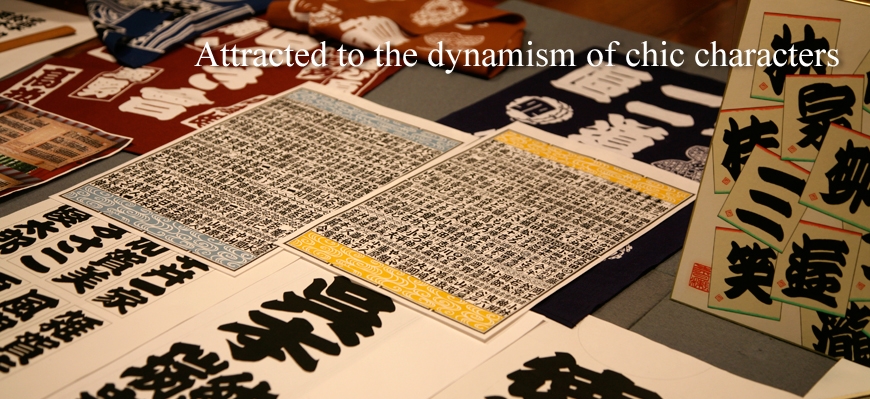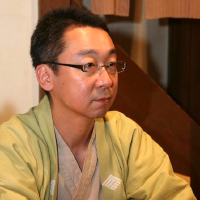
Hirohisa Nagase
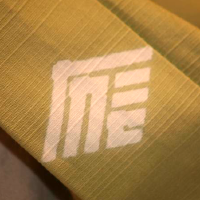
Katakana characters representing "Nagase" are dyed on a happy coat's collar. His particular attachment for chic characters can be found in the design.
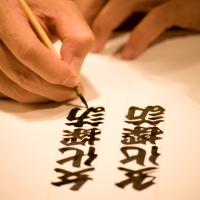
He writes Chinese characters representing "Bunka Tanho," or cultural fieldwork. (Yose and Edo characters are written on the right and left sides, respectively.)
What is an Edo character?
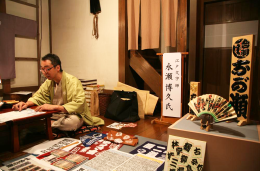
What is the charm of Edo characters?
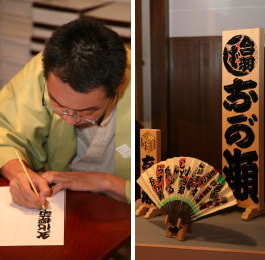
Right) Wooden signboard on which Chinese characters representing "Kappabashi Kana, Se (Nagase)" are written
Although, nowadays, pieces of printing type in the old days become fonts and there are a variety of characters and letters, to which lettering is applied using PCs, handwritten characters are still powerful and impressive as if they leap to our eyes. There are scenes in which characters stand out. Kantei-ryu Moji is used for Kabuki, Sumo Moji is used for Sumo, and Yose Moji is used for "Rakugo," or traditional Japanese comic storytelling. I am attracted to the styles of these various characters, which were born out of popular cultures of Edo and developed for the general public.
How did Nagase become an Edo-style calligrapher?
Could you tell me why you became an Edo-style calligrapher?
I was born in Minato-cho, Chuo Ward, and raised in Matsuba-cho (present-day Matsugaya), Taito City, so I have seen Edo characters in various places and scenes from a young age. When I saw cards that were offered to shrines and temples and characters written on "happi" coats, I was vaguely hoping that I could write those characters. I found an article in a magazine that introduced a class of Ukon Tachibana, a Yose character calligrapher and the head of the Tachibana School, so I contacted the shool immediately. Then, I enrolled in a class of Ukitsu Tachibana, who is may master, and learned Yose characters. I was also interested in Senja-fuda, so I belonged to Toto Nosatsu Mutsumi (Nosatsu, Tachibana-ren). I had a greater opportunity to get a close look at Edo characters written on a variety of old cards through communication with many members of the association, and became more eager to write the characters.
From what age did you start attending the class of Ukitsu Tachibana?
I enrolled in the class in April 1994. It was when I was 29 years old. I am now 46 years old, so I have attended the class for 17 years.
How long did you study the calligraphy? What kind of job did you do while attending the class?
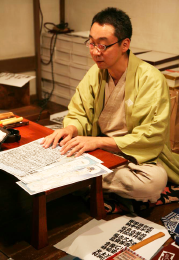
As an Edo-style calligrapher
Do you have many opportunities to listen to Rakugo as part of your work? Are there jobs that Rakugo storytellers ask you to do?
I sometimes listen to Rakugo. I was taught that I can write better Edo characters if I learn not only characters but also their history and cultures while being involved in its world (Yose and Senja) and having firsthand knowledge of them. By chance I have made printed materials, such as leaflets, tickets and pamphlets, for "Suzumoto Engeijo," or Suzumoto entertainment hall, in Ueno. When I work as a staff member for a Rakugo show, I also write Mekuri and programs of the day on the spot. Some people take photos of the programs with cell-phone cameras.
When are you asked to write (use) Edo characters? On what other items do you write the characters?
Wooden signboard makers ask me to write individuals' names and company names, which are engraved on large and small wooden signboards, votive tablets and other items. I sometimes write town association names and amateur club names, which are used for hand towels and yukata. I also design crests on happi coats. I write Edo characters on a variety of items. For example, I directly write the characters on paper with which fans are made. I write actual size characters corresponding to finished products, so characters are not reduced and blurred.
Have you taken apprentices?
I do not take apprentices. I may have some opportunities to teach skills in the future, but I have not yet think about it.
Toto Nosatsu Mutsumi
What kind of association is Toto Nosatsu Mutsumi?
It is one of the Senja-fuda exchange associations which have continued since the age of "Daimei Nosatsu," an older style of Senja-fuda. Daimei Nosatsu appeared in the Edo Period, and were developed and became popular in the Meiji, Taisho and Showa Periods. Toto Nosatsu Mutsumi is the oldest association that dates back to more than 110 years ago. Daimei Nosatsu refers to an action representing a folk belief that, if people offer their name cards to shrines and temples (paste the cards on shrines and temples), it is the same as they stay in the shrines and temples, so they can gain all merits for it. Nowadays, Daimei Nosatsu is held four times in a year at "Tokudaiji, Marishiten" in Ueno Okachimachi, and well attended as a party of Senja-fuda lovers.
What kind of process do you go through to complete one Senja-fuda?
First of all, a calligrapher or painter makes a draft, and it is transferred on a cherry woodblock. Then, an engraver carves woodblocks for each color. Finally, a printer overprint colors on traditional Japanese paper, making a multicolored print. So it is a woodblock print. It can be completed using the same method as Ukiyo-e.
What are the feature and the difference from machine printing?
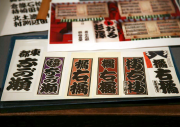
Tools
How many kinds of brushes do you have? How many brushes do you mainly use?
I use 7 or 8 types of brushes according to sizes and types of characters. There are brushes that I bought in order to try them out. Some were hard to write with because they are too soft. Others were loose and unusable though they were the same types of brushes that I bought before. There are also brushes that were worn out. I am reluctant to discard these brushes, so I keep all bulrushes. I think there are nearly 100 brushes. There are about 10 easy-to-use brushes that I have usually used.
When you write each character, are writing styles different?
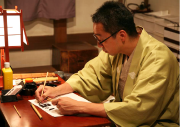

Hirohisa Nagase

Katakana characters representing "Nagase" are dyed on a happy coat's collar. His particular attachment for chic characters can be found in the design.

He writes Chinese characters representing "Bunka Tanho," or cultural fieldwork. (Yose and Edo characters are written on the right and left sides, respectively.)
What is an Edo character?

Edo characters were developed and ramified while receiving an influence of the Oie School's characters which were necessary when writing official documents. In the present, there are four broadly divided categories; "Kantei-ryu Moji," or Kantei Shool's characters, which are used for titles of Kabuki performances, "Sumo Moji." or Sumo characters, which are used for Sumo ranking charts, "Yose Moji," or Yose characters, which are used for traditional Japanese variety theaters, and "Edo Moji (narrow sense)," or Edo characters, which are mainly used for Senja-fuda. "Edo Moji (wide sense)" is a general term for all of these characters.
What is the charm of Edo characters?

Right) Wooden signboard on which Chinese characters representing "Kappabashi Kana, Se (Nagase)" are written
Although, nowadays, pieces of printing type in the old days become fonts and there are a variety of characters and letters, to which lettering is applied using PCs, handwritten characters are still powerful and impressive as if they leap to our eyes. There are scenes in which characters stand out. Kantei-ryu Moji is used for Kabuki, Sumo Moji is used for Sumo, and Yose Moji is used for "Rakugo," or traditional Japanese comic storytelling. I am attracted to the styles of these various characters, which were born out of popular cultures of Edo and developed for the general public.






